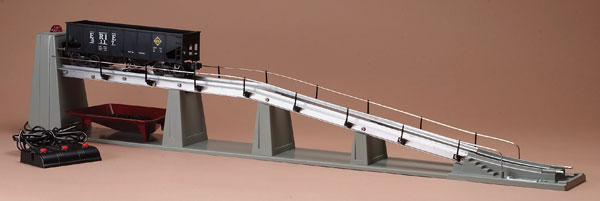During the postwar era, Lionel cataloged four accessories whose job it was to move coal. The no. 97 Coal Elevator was a carryover from the prewar years. Like the no. 397 Diesel-Type Coal Loader that came out in 1948, it raised the pellets up high and then let them fall into a dump car. The no. 497 Coaler, introduced in 1953, also made verticality synonymous with play value.
But the no. 456 Coal Ramp, which made its debut in 1950, was different. It is one of the longest accessories Lionel ever cataloged. Almost three feet long, it enables an operator to simulate the exciting action of dumping coal from a hopper car into a bin below or, even better, the empty tray of a 397. The latter then generates power to pour the coal into a waiting freight car. The action seemed realistic and delighted a lot of kids and their families long after Lionel deleted the 456 after 1955.
Operators, eager to add this cool accessory to their layouts, had to search for working examples at train shows and from dealers. They could expect to pay well over $250 for one in like-new condition. Now, however, with Lionel reissuing the 456 their woes are over. Hobbyists just have to be sure they have enough space for this massive piece, which is priced at $199.95.
Unpacking our no. 6-14005 Operating Coal Ramp, we found the ramp, a removable plastic bin, a bag of coal, and a controller. The ramp consists of a die-cast bottom frame, extruded aluminum ramp, stamped-metal base and handrail stanchions, detailed molded support towers, ElectroCoupler, two electromagnets, and an exterior red light.
“Where’s the car?” we asked. Sorry, but the operating hopper that you need for this accessory doesn’t come with it. You can pick up a postwar no. 3456 or one of the modern-era reissues, or get the new version (no. 6-19885) that’s cataloged at $39.95.
After scrounging up a hopper, we secured the five insulated wires from the controller to the accessory and a transformer. The instructions recommend 12 to 18 volts to operate the coal ramp. Then we connected some O gauge straight track to the track at the end of the ramp (O-27 also works) and had our locomotive push the hopper filled with coal to the top of the line until the car coupled with the stationary ElectroCoupler in the end tower.
The red light immediately went on to indicate that the car was coupled. Pushing the “Uncouple” button on the controller released the car from the locomotive, which went down the incline.
Pressing the “Unload” button started up the second action. The doors on the bottom of the hopper opened, and the coal dumped into the holding bin below. Once the shipment was emptied, pushing the “Release” button uncouples the freight car from the end of the loader. Or it should. Unfortunately, the ElectroCoupler did not want to let go. We tried and tried and then had no choice but to use the old five-finger method. I spoke with a local Lionel Value-Added Dealer, and he said his customers had experienced the same thing until they cranked up their transformer to 20VAC. Then the ElectroCoupler opened and let the car roll down the ramp.
Even with the balky ElectroCoupler, everyone here thinks the reissued Coal Ramp is a neat accessory. For twice the action, place it over a 397 coal loader and give some miniature black diamonds the ride of their life. That way, you won’t be left out in the coaled!















Excellent review and right on point. In my childhood I did not have any of these but now I own 3 out of the 4, the 97 being the last to get. Moving coal certainly holds your interest, even if much of it misses the target as the 397 spews alot of it on the layout and getting the voltage just right so that the automatic dump car gets the coal in the 497's awaiting bin. Using the 456 with the 397 is by far the best method for those two.